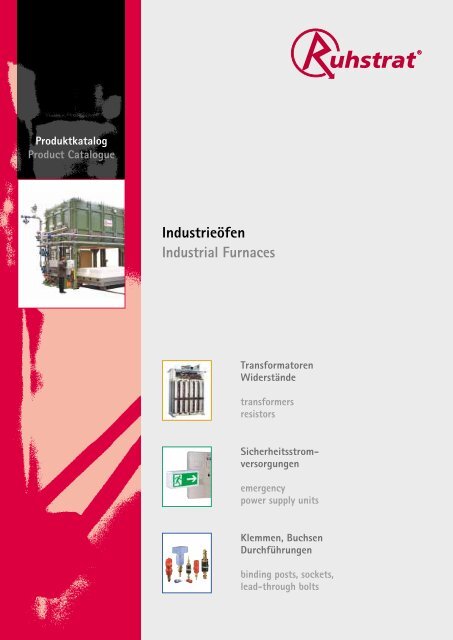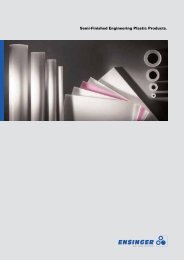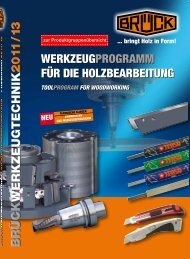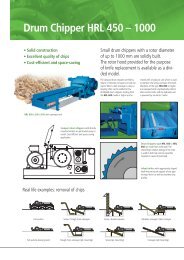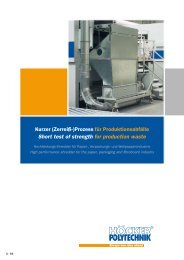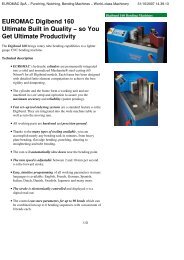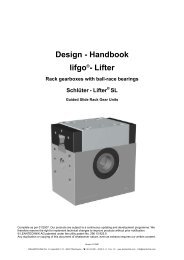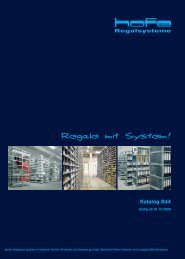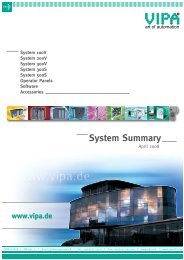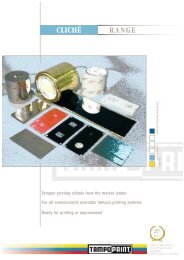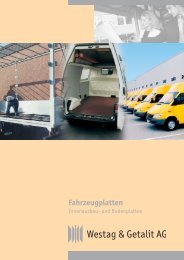Industrieöfen Industrial Furnaces - CeeIndustrial
Industrieöfen Industrial Furnaces - CeeIndustrial
Industrieöfen Industrial Furnaces - CeeIndustrial
Create successful ePaper yourself
Turn your PDF publications into a flip-book with our unique Google optimized e-Paper software.
Produktkatalog<br />
Product Catalogue<br />
<strong>Industrieöfen</strong><br />
<strong>Industrial</strong> <strong>Furnaces</strong><br />
Transformatoren<br />
Widerstände<br />
transformers<br />
resistors<br />
Sicherheitsstromversorgungen<br />
emergency<br />
power supply units<br />
Klemmen, Buchsen<br />
Durchführungen<br />
binding posts, sockets,<br />
lead-through bolts
Inhalt<br />
Content<br />
2<br />
Produktoptimierung und Prozessinnovation mit RUHSTRAT-Erwärmungsanlagen<br />
Product Optimizing and Process Innovation with RUHSTRAT Thermal Treatment Plants<br />
Projektbezogene Technologie in der Wärmebehandlung<br />
Thermal Treatment Technology Specially Matched to the Project<br />
Gliederung in die Kategorien Verfahren und Rohstoff<br />
Sub-Division into “Process” and “Raw Materials”<br />
Öfen und Anwendungsbeispiele<br />
Examples of <strong>Furnaces</strong> and their Applications<br />
Hochtemperaturöfen<br />
High-Temperature <strong>Furnaces</strong><br />
Kammeröfen, Muffelöfen<br />
Batch <strong>Furnaces</strong>, Muffle <strong>Furnaces</strong><br />
Drehherdöfen, Drehtelleröfen,<br />
Herdwagenöfen<br />
Rotary Hearth <strong>Furnaces</strong>,<br />
Rotary Plate <strong>Furnaces</strong>,<br />
Bogie Hearth <strong>Furnaces</strong><br />
Schachtöfen, Tiegelöfen,<br />
Haubenöfen, Truhenöfen<br />
Pit <strong>Furnaces</strong>, Crucible <strong>Furnaces</strong>,<br />
Bell <strong>Furnaces</strong>, Vertical Loading<br />
<strong>Furnaces</strong><br />
Rohröfen, Drehrohröfen,<br />
Drehtrommelöfen<br />
Tube <strong>Furnaces</strong>, Rotary Tube<br />
<strong>Furnaces</strong>, Rotary Drum <strong>Furnaces</strong><br />
6–7<br />
8–9<br />
10–11<br />
12–13<br />
14–15<br />
Komponenten für Wärmebehandlungsanlagen<br />
Components for Thermal Treatment Plants<br />
System-Prozesssteuerung<br />
System Process Control<br />
Durchschuböfen<br />
Pusher-Type <strong>Furnaces</strong><br />
Durchzugöfen<br />
Drawing <strong>Furnaces</strong><br />
Rollenherdöfen,<br />
Förderbandöfen,<br />
Förderkettenöfen<br />
Roller Hearth <strong>Furnaces</strong>,<br />
Conveyer Belt <strong>Furnaces</strong>,<br />
Conveyer Chain <strong>Furnaces</strong><br />
Laboröfen für diverse ISO-Normen,<br />
Laboröfen als Molekularsiebtrockner<br />
Laboratory <strong>Furnaces</strong> for<br />
Diverse ISO-Standards,<br />
Laboratory <strong>Furnaces</strong> as<br />
Molecular Filter Dryers<br />
Ruhstrat GmbH<br />
Heinestrasse 12<br />
D-37120 Bovenden-Lenglern<br />
Tel +49 (0) 55 93 803-0<br />
Fax +49 (0) 55 93 803-50<br />
E-Mail: info@ruhstrat.com<br />
Internet: www.ruhstrat.com<br />
Abteilung: <strong>Industrieöfen</strong><br />
Tel +49 (0) 55 93 803-36<br />
Fax +49 (0) 55 93 803-55<br />
Division: industrial furnaces<br />
phone +49 (0) 55 93 803-36<br />
fax +49 (0) 55 93 803-55<br />
E-Mail: matthias.muck@ruhstrat.com<br />
Technische und formale Änderungen bleiben vorbehalten. | We reserve the right of technical and formal alterations. Stand April 2003 | As of April 2003<br />
16–17<br />
18–19<br />
20–23<br />
24–25<br />
3<br />
4<br />
5<br />
6-25<br />
26<br />
27
D E<br />
Seit über 100 Jahren Temperaturen bis 3.000 °C<br />
In Zusammenarbeit mit RUHSTRAT entwickelte Prof. Walter Nernst<br />
1896 an der Universität Göttingen den ersten Kohlerohr-Kurzschlussofen,<br />
mit dem Temperaturen bis 3000 °C erreicht werden<br />
können. Bereits zwei Jahre später wurden RUHSTRAT die Entwicklung<br />
und der Bau dieser ersten Hochtemperaturöfen für industrielle<br />
Zwecke übertragen. Seit dieser Zeit konzipiert, konstruiert, fertigt<br />
und liefert RUHSTRAT weltweit <strong>Industrieöfen</strong> für unterschiedlichste<br />
Wärmebehandlungen und Branchen.<br />
Produktoptimierung und Prozessinnovation<br />
Wenn es um die Lösung produktionstechnischer Probleme mit Hilfe<br />
von thermischen Wärmebehandlungsanlagen geht, ist RUHSTRAT Ihr<br />
kompetenter Partner. Aufgrund unserer langjährigen Erfahrung bei<br />
Wärmebehandlungen in der metallverarbeitenden, chemischen und<br />
keramischen Industrie sowie der Leuchtmittelindustrie steht uns<br />
heute ein umfassendes Know-how für die Produktoptimierung und<br />
Prozessinnovation unserer Kunden zur Verfügung.<br />
Abb. 3.1 Unternehmensansicht<br />
fig. 3.1 view of the Ruhstrat company<br />
Projektbezogene Technologie<br />
Mit der projektbezogenen Konstruktion und Herstellung von elektrisch<br />
und brennstoffbeheizten Erwärmungsanlagen, mit oder ohne<br />
Schutz- oder Reaktionsgas, bietet RUHSTRAT maßgeschneiderte<br />
Problemlösungen, um optimal auf den Kunden abgestimmte Resultate<br />
zu erzielen. Qualifizierte RUHSTRAT-Ingenieure erörtern in intensiven<br />
Gesprächen mit dem Kunden dessen Anforderungen und<br />
konzipieren bzw. konstruieren eine ganz speziell auf diese Kundenanforderungen<br />
abgestimmte Erwärmungsanlage. Mit den individuell<br />
ausgelegten dazugehörigen Peripherie-Einrichtungen wie Handhabungs-,<br />
Kühl-, Antriebs- und Transportsystemen, Prozesssteuerung<br />
und Schutzgas- bzw. Prozessgaseinrichtungen bietet RUHSTRAT<br />
seinen Kunden ein Komplettangebot für Erwärmungsanlagen in<br />
Industrie und Forschung.<br />
Inbetriebnahme beim Kunden<br />
Da die RUHSTRAT-Einzelanfertigungen ganz speziell auf die<br />
Besonderheiten des Einsatzes beim Kunden abgestimmt sind, wird<br />
auf Wunsch die Erwärmungsanlage beim Kunden installiert und die<br />
Inbetriebnahme sowie die Personalschulung durch RUHSTRAT-<br />
Ingenieure und -Techniker vorgenommen, um einen reibungslosen<br />
Arbeitsablauf für den nachfolgenden Produktionsprozess sicherzustellen.<br />
Produktoptimierung und Prozessinnovation mit RUHSTRAT-Erwärmungsanlagen<br />
Product Optimizing and Process Innovation with RUHSTRAT Thermal Treatment Plants<br />
For more than 100 years temperatures up to 3,000 °C<br />
In collaboration with RUHSTRAT Prof. Walter Nernst designed the<br />
first carbon tube short-circuit furnace achieving 3,000 °C (5,432° F)<br />
in 1896 at the University of Göttingen. Two years later, design and<br />
construction of the first high-temperature furnace for industrial<br />
purposes were transferred to RUHSTRAT. Since that time, RUHSTRAT<br />
has been planing, constructing, producing and delivering industrial<br />
furnaces world-wide for different thermal treatments and branches.<br />
Product Optimizing and Process Innovation<br />
Whenever technical production problems are to be solved by means<br />
of thermal treatment plants RUHSTRAT is your competent partner.<br />
Thanks to many years of experience in thermal treatment in the<br />
metal-processing, chemical and ceramic industry as well as in the<br />
illuminant industry RUHSTRAT nowadays has an extensive knowhow<br />
concerning product optimizing and process innovation.<br />
Abb. 3.2 Einsatzgebiet<br />
fig. 3.2 range of application<br />
Technology Specially Matched to the Project<br />
With the construction and manufacture of electrically heated or<br />
combustible-heated thermal treatment plants, specially matched to<br />
the project, with or without protective- or reaction-gas RUHSTRAT<br />
provides tailor-made solutions, in order to achieve results which are<br />
optimally matched to the requirements of the customer. During<br />
intensive conversations with the customer qualified RUHSTRAT<br />
engineers discuss in detail his requirements and conceive resp.<br />
construct a thermal treatment plant which is specially matched to<br />
these requirements. With the individually designed necessary<br />
periphery equipment, such as handling systems, cooling systems,<br />
drive and transport systems, process control and protective gas<br />
devices resp. process gas devices RUHSTRAT provides full service for<br />
thermal treatment plants in industry and research.<br />
Commissioning in the Customer’s Facilities<br />
As the individually tailor-made products of RUHSTRAT are specially<br />
matched to the particular application in the customer’s facilities,<br />
the thermal treatment plant is – if desired – installed at the<br />
customer’s facilities and the commissioning as well as the training<br />
course are carried out by engineers and technicians of RUHSTRAT,<br />
in order to assure a frictionless working procedure for the following<br />
production process.<br />
Stand April 2003 | As of April 2003 Technische und formale Änderungen bleiben vorbehalten. | We reserve the right of technical and formal alterations.<br />
<strong>Industrieöfen</strong> | <strong>Industrial</strong> <strong>Furnaces</strong><br />
3
<strong>Industrieöfen</strong> | <strong>Industrial</strong> <strong>Furnaces</strong><br />
Projektbezogene Technologie in der Wärmebehandlung<br />
Thermal Treatment Technology Specially Matched to the Project<br />
4<br />
Projektberatung beim Kunden<br />
project advice for the customer<br />
Qualifizierte RUHSTRAT-Ingenieure<br />
erörtern in intensiven Gesprächen mit<br />
dem Kunden dessen Anforderungen....<br />
During intensive conversations with<br />
the customer qualified RUHSTRAT<br />
engineers discuss in detail his<br />
requirements…<br />
Vor Auslieferung durchlaufen fast<br />
alle Anlagen in unserem Haus eine<br />
Testphase. Die vorbeugende<br />
Kontrolle bringt bei den hohen<br />
Qualitäts- und Leistungsansprüchen,<br />
denen Produktionsanlagen<br />
täglich ausgesetzt sind,<br />
ein zusätzliches Plus an Sicherheit.<br />
Almost all our plants have to undergo<br />
a test phase in our factory<br />
before they are dispatched. In<br />
view of the high demands concerning<br />
quality and performance the<br />
production plants are exposed to<br />
every day the preventive control<br />
constitutes an increase of safety.<br />
Da die RUHSTRAT-Einzelfertigungen<br />
ganz speziell auf die Besonderheiten<br />
des Einsatzes beim Kunden abgestimmt<br />
sind, wird auf Wunsch die Erwärmungsanlage<br />
beim Kunden installiert...<br />
As the individually tailor-made<br />
products of RUHSTRAT are specially<br />
matched to the particular application<br />
in the customer’s facilities, the<br />
thermal treatment plant is – if desired<br />
- installed at the customer’s site ...<br />
.... und die Inbetriebnahme durch RUHSTRAT-Ingenieure<br />
und -Techniker ausgeführt. RUHSTRAT überwacht<br />
das Einfahren der Anlage und schult das Bedienungspersonal,<br />
um einen reibungslosen Arbeitsablauf für<br />
den nachfolgenden Produktionsprozess sicherzustellen.<br />
... and the commissioning is carried out by engineers<br />
and technicians of RUHSTRAT. RUHSTRAT supervises<br />
the insertion of the plant and holds training courses<br />
for the staff, in order to assure a frictionless working<br />
procedure for the following production process.<br />
Konzeption einer für den Kunden<br />
optimierten Wärmebehandlungsanlage<br />
conception of a thermal treatment plant<br />
optimized for the customer’s application<br />
Anlagentest<br />
test of the plant<br />
Demontage | Installation<br />
disassembly | installation<br />
Konstruktion<br />
construction<br />
Ausführung | Herstellung<br />
performance | manufacture<br />
Inbetriebnahme | Personalschulung<br />
commissioning | training of the staff<br />
...und konzipieren eine ganz speziell auf diese Kundenanforderungen<br />
abgestimmte Wärmebehandlungsanlage.<br />
…and conceive a thermal treatment plant which is<br />
specially matched to these requirements.<br />
Mit modernen Hilfsmitteln<br />
konstruieren<br />
unsere Mitarbeiter<br />
kundenoptimierte<br />
Problemlösungen in<br />
der Wärmebehandlung.<br />
By means of modern<br />
technologies our<br />
employees construct<br />
thermal treatment<br />
solutions which are<br />
optimized for the customers’s<br />
application.<br />
Hoch qualifiziertes Personal und<br />
entsprechendes Equipment geben<br />
RUHSTRAT die Möglichkeit, die<br />
meisten Produktionsschritte im<br />
eigenen Haus durchzuführen.<br />
Highly qualified staff and the<br />
corresponding equipment make it<br />
possible for RUHSTRAT to carry<br />
out most of the production steps<br />
in our own facilities.<br />
Wartung | 24 h Service | Ersatzteilversorgung<br />
maintenance | 24 h service | spare parts supply<br />
Der lange Lebenszyklus unserer<br />
Anlagen wird neben dem Service<br />
durch die kompetente und rasche<br />
Ersatzteilversorgung gesichert.<br />
Apart from the service the long<br />
life expectancy of our plants is<br />
assured by competent and quick<br />
spare part supply.<br />
Technische und formale Änderungen bleiben vorbehalten. | We reserve the right of technical and formal alterations. Stand April 2003 | As of April 2003
D E<br />
Mit der projektbezogenen Konstruktion und Herstellung von elektrisch<br />
und brennstoffbeheizten Erwärmungsanlagen kann RUHSTRAT<br />
die Anforderungen seiner Kunden erfüllen, auch wenn sie noch so<br />
spezifisch sind. Obwohl je nach Land und Aufgabenstellung kaum<br />
ein Projekt dem anderen gleicht, sind wir in der Lage, auf Modifikationen<br />
ganz gezielt einzugehen. Die Basis dafür stellt unsere breite<br />
Palette von Öfen und Anlagentypen dar. Damit Sie eine Vorstellung<br />
davon bekommen, wie unsere Lösungen im Speziellen aussehen,<br />
haben wir sie hier zusammengefasst. Die Gliederung in die Kategorien<br />
Verfahren und Rohstoff soll Ihre Suche erleichtern.<br />
Schmelzen<br />
Stahl, Eisen und Legierungen<br />
Leichtmetalle und Legierungen<br />
Edelmetalle und Legierungen<br />
Sonstige Metalle und Legierungen<br />
Keramik, Glas und synthetische Stoffe<br />
Organische und anorganische Stoffe<br />
Erwärmen | Warmhalten<br />
Stahl, Eisen und Legierungen<br />
Leichtmetalle und Legierungen<br />
Edelmetalle und Legierungen<br />
Sonstige Metalle und Legierungen<br />
Organische und anorganische Stoffe<br />
Wärmebehandlung von Metallen<br />
Härten<br />
Vergüten<br />
Löten<br />
Glühen<br />
Sintern<br />
Anlassen<br />
Aufkohlen<br />
Nitrieren<br />
thermisch reinigen<br />
Reinigen | Trocknen<br />
Entfetten<br />
Waschen<br />
Trocknen<br />
Abkühlen<br />
Kühlen<br />
Abschrecken<br />
Tieftemperatur-Behandeln<br />
Pulvermetallurgie<br />
Entwachsen<br />
Sintern<br />
Wärmebehandlung von organ. und anorgan. Stoffen<br />
Kalzinieren<br />
Sintern<br />
Kondensieren<br />
Reduzieren<br />
Gliederung in die Kategorien Verfahren und Rohstoff<br />
Sub-Division into “Process” and “Raw Materials”<br />
By means of the project-related construction and manufacture of<br />
electrically heated and combustible-heated thermal treatment plants<br />
RUHSTRAT can fulfil the requirements of their customers, even very<br />
specific demands. Although one project is hardly like the other one –<br />
depending on country and requirements –, we are able to specifically<br />
consider any modifications. The basis for this is represented by our wide<br />
range of furnaces and plant types. In order to give you an idea of how<br />
our solutions can look like in detail, we have summarized them for<br />
you below. The sub-division into the categories process and raw material<br />
is supposed to help you find the information you are looking for.<br />
Melting<br />
steel, iron and alloys<br />
light metals and alloys<br />
precious metals and alloys<br />
other metals and alloys<br />
ceramics, glass and synthetic materials<br />
organic and inorganic materials<br />
Heating | Holding<br />
steel, iron and alloys<br />
light metals and alloys<br />
precious metals and alloys<br />
other metals and alloys<br />
organic and inorganic materials<br />
Thermal Treatment of Metals<br />
hardening<br />
heat-treatment<br />
soldering<br />
annealing<br />
sintering<br />
tempering<br />
carbonizing<br />
nitriding<br />
thermal cleaning<br />
Cleaning | Drying<br />
degreasing<br />
washing<br />
drying<br />
Cooling<br />
cooling<br />
quenching<br />
low-temperature treatment<br />
Powder Metallurgy<br />
dewaxing<br />
sintering<br />
Thermal Treatment of Organic and Inorganic Materials<br />
calcining<br />
sintering<br />
condensing<br />
reducing<br />
Stand April 2003 | As of April 2003 Technische und formale Änderungen bleiben vorbehalten. | We reserve the right of technical and formal alterations.<br />
<strong>Industrieöfen</strong> | <strong>Industrial</strong> <strong>Furnaces</strong><br />
5
<strong>Industrieöfen</strong> | <strong>Industrial</strong> <strong>Furnaces</strong><br />
Öfen und Anwendungsbeispiele<br />
Examples of <strong>Furnaces</strong> and their Applications<br />
6<br />
Hochtemperatur-Ofenanlagen bis 3000 °C<br />
High-Temperature Furnace Plants up to 3000 °C<br />
D E<br />
direkt/indirekt elektrisch beheizt<br />
zum Schmelzen, Legieren, Sintern, Brennen von Keramiken,<br />
Metalluntersuchungen, Carbonisieren und Grafitieren,<br />
für Warmbehandlungen unter Schutzgas und Vakuum<br />
für Metallurgie, Glas, Keramik<br />
Hochtemperatur-Rohrofen System NERNST-TAMMANN<br />
z. B. zum Schmelzen von Edelmetallen<br />
diskontinuierlicher Prozess<br />
bis 3.000 °C<br />
Hochtemperatur-Rohrofen<br />
z. B. zum Grafitieren von Kohlenstofffasern<br />
kontinuierlicher Prozess<br />
bis 2.800 °C<br />
Carbonisierungs-Hochtemperaturofen<br />
z. B. zum Carbonisieren von Kohlenstofffasern<br />
kontinuierlicher Prozess<br />
bis 2.500 °C<br />
Hochtemperatur-Durchschub-Sinteranlage<br />
z. B. zum Sintern von Pulvermetall oder Keramikelementen<br />
unter Schutzgasatmosphäre<br />
kontinuierlicher Prozess<br />
bis 2.800 °C<br />
Abb. 6.1<br />
Carbonisierungs-<br />
Hochtemperaturofen<br />
(2.500 °C)<br />
fig. 6.1<br />
high-temperature<br />
carbonizing furnace<br />
(2,500 °C)<br />
directly/indirectly electrically heated<br />
for melting, alloying, sintering, burning of ceramics, analysis of<br />
metal (metallurgical tests), graphiting and carbonizing, thermal<br />
treatments under protective gas and vacuum atmosphere<br />
for metallurgy, glass, ceramics<br />
High-Temperature Tube Furnace NERNST-TAMMANN System<br />
e. g. for melting of precious metals<br />
batch process<br />
up to 3,000 °C<br />
High-Temperature Tube Furnace<br />
e. g. for graphiting of carbon fibres<br />
continuous process<br />
up to 2,800 °C<br />
High-Temperature Carbonizing Furnace<br />
e. g. for carbonizing of carbon fibres<br />
continuous process<br />
up to 2,500 °C<br />
High-Temperature Pusher-Type Sintering Plant<br />
e. g. for sintering of powder metal or ceramic elements<br />
under protective gas atmosphere<br />
continuous process<br />
up to 2,800 °C<br />
Technische und formale Änderungen bleiben vorbehalten. | We reserve the right of technical and formal alterations. Stand April 2003 | As of April 2003
Abb. 7.1<br />
Hochtemperatur-<br />
Vertikalrohrofen bis<br />
2.200 °C zur Wärmebehandlung<br />
unter<br />
Schutzgas von<br />
Pulvern und<br />
Granulaten in der<br />
chemischen Industrie<br />
fig. 7.1<br />
high-temperature<br />
vertical tube furnace<br />
up to 2,200 °C for<br />
thermal treatment<br />
of powders and<br />
granules in the<br />
chemical industry<br />
under protective gas<br />
Öfen und Anwendungsbeispiele<br />
Examples of <strong>Furnaces</strong> and their Applications<br />
Abb. 6.2<br />
Hochtemperatur-Durchschubofen-Anlage<br />
bis 1.600 °C<br />
zum Sintern von Formteilen<br />
unter Wasserstoff-<br />
Schutzgasatmosphäre<br />
fig. 6.2<br />
high-temparature pushertype<br />
furnace plant up to<br />
1,600 °C for sintering<br />
structural parts in hydrogencontrolled<br />
atmosphere<br />
Stand April 2003 | As of April 2003 Technische und formale Änderungen bleiben vorbehalten. | We reserve the right of technical and formal alterations.<br />
<strong>Industrieöfen</strong> | <strong>Industrial</strong> <strong>Furnaces</strong><br />
7
<strong>Industrieöfen</strong> | <strong>Industrial</strong> <strong>Furnaces</strong><br />
Öfen und Anwendungsbeispiele<br />
Examples of <strong>Furnaces</strong> and their Applications<br />
8<br />
Kammeröfen, Muffelöfen<br />
Batch <strong>Furnaces</strong>, Muffle <strong>Furnaces</strong><br />
D E<br />
indirekt elektrisch oder brennstoffbeheizt<br />
zum Entspannen, Anlassen, Härten, Aufkohlen, Carbonitrieren,<br />
Nitrocarburieren, Glühen, Rekristallisieren, Normalisieren,<br />
Weichglühen, Isothermglühen, Warmbehandeln<br />
unter Schutzgas, Vakuum und oxidierender Atmosphäre<br />
für Metallurgie, Glas, Keramik, Chemie<br />
Kammerofen<br />
z. B. zum Warmbehandeln von Stahl, Glas, Keramik<br />
diskontinuierlicher Prozess<br />
bis 1.550 °C<br />
Muffelofen<br />
z. B. zum Lösungsglühen von Aluminium<br />
diskontinuierlicher Prozess<br />
bis 650 °C<br />
Muffelofen<br />
z. B. zum Wachsausschmelzen von Sintermetallelementen<br />
diskontinuierlicher Prozess<br />
bis 1.000 °C<br />
Muffelofen<br />
z. B. zum Glühen und Härten von Stahlteilen unter<br />
oxidierender und nichtoxidierender Atmosphäre<br />
diskontinuierlicher Prozess<br />
bis 1.150 °C<br />
Abb. 8.1<br />
Kammerofen<br />
(1.100 °C)<br />
fig. 8.1<br />
batch furnace<br />
(1,100 °C)<br />
Abb. 8.2<br />
Muffelofen (650 °C) zum<br />
Lösungsglühen von<br />
Aluminiumteilen<br />
fig. 8.2<br />
muffle furnace (650 °C)<br />
for solution treatment<br />
of aluminium parts<br />
indirectly electrically heated or combustible-heated<br />
for relieving, tempering, hardening, carburizing, dry-cyaniding,<br />
nitrocarburizing, annealing, recrystallizing, normalizing, soft<br />
annealing, isothermal annealing, thermal treatment under<br />
protective gas, vacuum and oxidizing atmosphere<br />
for metallurgy, glass, ceramics, chemistry<br />
Batch Furnace<br />
e. g. for thermal treatment of steel, ceramics, glass<br />
batch process<br />
up to 1,550 °C<br />
Muffle Furnace<br />
e. g. for solution treatment of aluminium<br />
batch process<br />
up to 650 °C<br />
Muffle Furnace<br />
e. g. for wax melting of dry powdered metal elements<br />
batch process<br />
up to 1,000 °C<br />
Muffle Furnace<br />
e. g. for annealing and hardening of steel parts<br />
under oxidizing and non-oxidizing atmosphere<br />
batch process<br />
up to 1,150 °C<br />
Technische und formale Änderungen bleiben vorbehalten. | We reserve the right of technical and formal alterations. Stand April 2003 | As of April 2003
Öfen und Anwendungsbeispiele<br />
Examples of <strong>Furnaces</strong> and their Applications<br />
Abb. 9.1<br />
Muffelofen bis 1.150 °C<br />
zur Wärmebehandlung<br />
unter Vakuum- und<br />
Schutzgasatmosphäre<br />
in der Metall- und<br />
chemischen Industrie<br />
(z. B. Wachsausschmelzen,<br />
Vorsintern,<br />
Tempern, Glühen)<br />
fig. 9.1<br />
muffle furnace up to<br />
1,150 °C for thermal<br />
treatment under<br />
vacuum atmosphere<br />
and inert gas atmosphere<br />
in the metallurgical<br />
and chemical<br />
industry<br />
(e. g. melting out of<br />
wax, presintering,<br />
tempering, annealing)<br />
Abb. 8.3<br />
Elektrisch beheizter<br />
Vakuum-Muffelofen<br />
mit Heißgasumwälzung<br />
bis 1.100 °C<br />
fig. 8.3<br />
electrically heated<br />
vacuum muffle furnace<br />
with hot gas ventilation<br />
up to 1,100 °C<br />
Stand April 2003 | As of April 2003 Technische und formale Änderungen bleiben vorbehalten. | We reserve the right of technical and formal alterations.<br />
<strong>Industrieöfen</strong> | <strong>Industrial</strong> <strong>Furnaces</strong><br />
9
<strong>Industrieöfen</strong> | <strong>Industrial</strong> <strong>Furnaces</strong><br />
Öfen und Anwendungsbeispiele<br />
Examples of <strong>Furnaces</strong> and their Applications<br />
10<br />
Drehherdöfen, Drehtelleröfen, Herdwagenöfen<br />
Rotary Hearth <strong>Furnaces</strong>, Rotary Plate <strong>Furnaces</strong>, Bogie Hearth <strong>Furnaces</strong><br />
D E<br />
indirekt elektrisch oder brennstoffbeheizt<br />
zum Entspannen, Anlassen, Glühen, Rekristallisieren,<br />
Weichglühen, Isothermglühen<br />
für Metallurgie, Glas, Keramik, Chemie<br />
Drehherdofen<br />
z. B. zum Glühen von Stahlteilen<br />
kontinuierlicher Prozess<br />
bis 1.150 °C<br />
Drehtellerofen<br />
z. B. zum Glühen von Formteilen (Prothesen)<br />
kontinuierlicher Prozess<br />
bis 1.150 °C<br />
Herdwagenofen<br />
z. B. zum Anlassen von Ronden für die Sägeindustrie<br />
sowie zum Glühen von Stahl<br />
diskontinuierlicher Prozess<br />
bis 1.100 °C<br />
Abb. 10.1<br />
Drehtellerofen<br />
(1.150 °C)<br />
fig. 10.1<br />
rotary plate<br />
furnace<br />
(1,150 °C)<br />
Abb. 10.2<br />
Herdwagenofen-Anlage<br />
bis 750 °C,<br />
6,6 m beheizte Länge,<br />
25 t Nutzlast,<br />
zum Anlassen von Stählen<br />
fig. 10.2<br />
bogie hearth furnace<br />
up to 750 °C,<br />
6.6 m heated length,<br />
25 t usable load,<br />
for tempering of steel<br />
indirectly electrically or combustible-heated<br />
for relieving, tempering, annealing, recrystallizing,<br />
soft annealing, isothermal annealing<br />
of metallurgy, glass, ceramics, chemistry<br />
Rotary Hearth Furnace<br />
e. g. for annealing of steel parts<br />
continuous process<br />
up to 1,150 °C<br />
Rotary Plate Furnace<br />
e. g. for annealing of formed parts (prothesis)<br />
continuous process<br />
up to 1,150 °C<br />
Bogie Hearth Furnace<br />
e. g. for tempering of rondes for the saw industry<br />
as well as for annealing of steel<br />
batch process<br />
up to 1,100 °C<br />
Technische und formale Änderungen bleiben vorbehalten. | We reserve the right of technical and formal alterations. Stand April 2003 | As of April 2003
Abb. 11.1<br />
Mobiler<br />
Drehherdofen<br />
bis 1.150 °C<br />
fig. 11.1<br />
moveable rotary<br />
hearth furnace<br />
up to 1,150 °C<br />
Öfen und Anwendungsbeispiele<br />
Examples of <strong>Furnaces</strong> and their Applications<br />
Stand April 2003 | As of April 2003 Technische und formale Änderungen bleiben vorbehalten. | We reserve the right of technical and formal alterations.<br />
<strong>Industrieöfen</strong> | <strong>Industrial</strong> <strong>Furnaces</strong><br />
11
<strong>Industrieöfen</strong> | <strong>Industrial</strong> <strong>Furnaces</strong><br />
Öfen und Anwendungsbeispiele<br />
Examples of <strong>Furnaces</strong> and their Applications<br />
12<br />
Schachtöfen, Tiegelöfen, Haubenöfen, Truhenöfen<br />
Pit <strong>Furnaces</strong>, Crucible <strong>Furnaces</strong>, Bell <strong>Furnaces</strong>, Vertical Loading <strong>Furnaces</strong><br />
D E<br />
indirekt elektrisch oder brennstoffbeheizt<br />
zum Entspannen, Anlassen, Aufkohlen, Carbonitrieren,<br />
Nitrocarburieren, Glühen, Rekristallisieren, Normalisieren,<br />
Weichglühen, Isothermglühen<br />
für Metallurgie, Keramik, Chemie<br />
Schachtofen mit Schutzgasbetrieb<br />
z. B. zum Anlassen von Bimetall-Sägeband<br />
oder Glühen von Runddraht<br />
diskontinuierlicher Prozess<br />
bis 1.100 °C<br />
Haubenofen mit Schutzgasbetrieb<br />
z. B. als gasdichte Prozessöfen für die chemische Industrie und<br />
zum Lösungsglühen für die Aluminium verarbeitende Industrie<br />
diskontinuierlicher Prozess<br />
bis 1.450 °C<br />
Truhenofen<br />
z. B. zum Glühen von Stahlprofilen<br />
diskontinuierlicher Prozess<br />
bis 1.000 °C<br />
Abb. 12.1<br />
Schachtofen zum<br />
Anlassen von Bimetall-<br />
Sägeband bis 650 °C<br />
inkl. Mess- und Regelstation,<br />
Wasser- und<br />
Gasverteilerstation<br />
und Vakuumpumpe<br />
fig. 12.1<br />
pit furnace<br />
for tempering of<br />
bimetal saw bands<br />
up to 650 °C incl.<br />
measuring, and<br />
control station,<br />
water- and gas<br />
distribution station<br />
and vacuum pump<br />
indirectly electrically or combustible-heated<br />
for relieving, tempering, carburizing, dry-cyaniding,<br />
nitrocarburizing, annealing, recrystallizing, normalizing,<br />
soft annealing, isothermal annealing<br />
for metallurgy, ceramics, chemistry<br />
Pit Furnace with Protective Gas Operation<br />
e. g. for tempering of bimetal saw bands<br />
or annealing of round wire<br />
batch process<br />
up to 1,100 °C<br />
Bell Furnace with Protective Gas Operation<br />
e. g. as gastight process furnaces for the chemical industry and<br />
for solution treatment for the aluminium-processing industry<br />
batch process<br />
up to 1,450 °C<br />
Vertical Loading Furnace<br />
e. g. for annealing of steel profiles<br />
batch process<br />
up to 1,000 °C<br />
Technische und formale Änderungen bleiben vorbehalten. | We reserve the right of technical and formal alterations. Stand April 2003 | As of April 2003
Öfen und Anwendungsbeispiele<br />
Examples of <strong>Furnaces</strong> and their Applications<br />
Abb. 13.1 + 13.2<br />
Elektrisch beheizter<br />
Hubherdofen bis<br />
1.500 °C, gasdicht,<br />
für neutrale Gase,<br />
inkl. Gas- und Wasser-<br />
Verteiler- und Regelstation<br />
fig. 13.1 + 13.2<br />
electrically heated<br />
elevator furnace up to<br />
1,500 °C, gastight,<br />
for neutral gases,<br />
incl. gas and water<br />
distribution and<br />
control station<br />
Stand April 2003 | As of April 2003 Technische und formale Änderungen bleiben vorbehalten. | We reserve the right of technical and formal alterations.<br />
<strong>Industrieöfen</strong> | <strong>Industrial</strong> <strong>Furnaces</strong><br />
13
<strong>Industrieöfen</strong> | <strong>Industrial</strong> <strong>Furnaces</strong><br />
Öfen und Anwendungsbeispiele<br />
Examples of <strong>Furnaces</strong> and their Applications<br />
14<br />
Rohröfen, Drehrohröfen, Drehtrommelöfen<br />
Tube <strong>Furnaces</strong>, Rotary Tube <strong>Furnaces</strong>, Rotary Drum <strong>Furnaces</strong><br />
D E<br />
indirekt elektrisch oder brennstoffbeheizt<br />
zum Legieren, Sintern, Brennen von Keramiken, für<br />
Warmbehandlungen unter Schutzgas und oxidierender<br />
Atmosphäre<br />
für Metallurgie, Keramik, Chemie<br />
Durchschub-Rohrofen-Sinteranlage mit Schutzgasbetrieb<br />
z. B. Reaktor zum Ablauf von chemischen Reaktionen<br />
kontinuierlicher Prozess<br />
bis 1.250 °C<br />
Klapprohrofen<br />
z. B. zum Einbau in Werkzeug-Prüfmaschinen<br />
für Warmzug- und Warmdruckversuche<br />
diskontinuierlicher Prozess<br />
bis 1.400 °C<br />
Drehrohrofen<br />
zum Ablauf von chemischen Reaktionen<br />
kontinuierlicher Prozess<br />
bis 1.200 °C mit Stahlrohr<br />
bis 1.500 °C mit keramischem Rohr<br />
Drehtrommelofen<br />
z. B. als Reaktionsofen für chemische Prozesse in Granulaten<br />
diskontinuierlicher Prozess<br />
bis 1.200 °C<br />
indirectly electrically or combustible-heated<br />
for alloying, sintering, burning of ceramics,<br />
for thermal treatments under protective gas<br />
and oxidizing atmoshere<br />
for metallurgy, ceramics, chemistry<br />
Pusher-Type Tube Furnace Plant for Continuous Sintering<br />
with Protective Gas Operation<br />
e. g. reactor for the progress of chemical reactions<br />
continuous process<br />
up to 1,250 °C<br />
Hinged Tube Furnace<br />
e. g. for insertion into test machines for tools<br />
for hot drawing and hot pressure tests<br />
batch process<br />
up to 1,400°C<br />
Rotary Tube Furnace<br />
e. g. for the progress of chemical reactions<br />
continuous process<br />
up to 1,200 °C with steel tube<br />
up to 1,500 °C with ceramic tube<br />
Rotary Drum Furnace<br />
e. g. as reaction furnace for chemical processes<br />
in granulated materials<br />
batch process<br />
up to 1,200 °C<br />
Abb. 14.1<br />
Drehrohrofen 1.100 °C<br />
mit gasdichtem Ein-<br />
und Ausgang<br />
fig. 14.1<br />
rotary tube furnace 1,100 °C<br />
with gastight charge<br />
and discharge<br />
Technische und formale Änderungen bleiben vorbehalten. | We reserve the right of technical and formal alterations. Stand April 2003 | As of April 2003
Öfen und Anwendungsbeispiele<br />
Examples of <strong>Furnaces</strong> and their Applications<br />
Abb. 15.1 + 15.2<br />
Drehtrommelofen bis 1.100 °C zur diskontinuierlichen Wärmebehandlung (Batchbetrieb) von Pulvern und<br />
Granulaten in der chemischen Industrie<br />
fig. 15.1 + 15.2<br />
rotary drum furnace up to 1,100 °C for discontinuous thermal treatment (batch operation) of powders<br />
and granules in the chemical industry<br />
Abb. 15.3<br />
Vertikalrohrofen bis 1.100 °C<br />
zur Wärmebehandlung von<br />
Pulvern und Granulaten in<br />
der chemischen Industrie<br />
fig. 15.3<br />
vertical tube furnace up<br />
to 1,100 °C for thermal<br />
treatment of powders and<br />
granules in the chemical<br />
industry<br />
Stand April 2003 | As of April 2003 Technische und formale Änderungen bleiben vorbehalten. | We reserve the right of technical and formal alterations.<br />
<strong>Industrieöfen</strong> | <strong>Industrial</strong> <strong>Furnaces</strong><br />
15
<strong>Industrieöfen</strong> | <strong>Industrial</strong> <strong>Furnaces</strong><br />
Öfen und Anwendungsbeispiele<br />
Examples of <strong>Furnaces</strong> and their Applications<br />
16<br />
D<br />
E<br />
Durchschuböfen<br />
Pusher-Type <strong>Furnaces</strong><br />
indirekt elektrisch oder brennstoffbeheizt<br />
als kontinuierlich arbeitende Anlagen zum Härten, Anlassen,<br />
und thermisch Reinigen von Messerklingen, Rasierklingen,<br />
technischen Klingen, chirurgischen Klingen etc.<br />
zum Kalzinieren und Reduzieren von chemischen Produkten<br />
für Metallurgie, Glas, Keramik, Chemie<br />
Durchschubofen<br />
z. B. zum thermisch Reinigen und zum Teflonisieren<br />
der Schneidkanten von Klingen<br />
kontinuierlicher Prozess<br />
bis 450 °C<br />
indirectly electrically or combustible-heated<br />
as continuously operating plants for hardening, tempering,<br />
and thermal cleaning of knife blades, razor blades, technical<br />
blades, surgical blades etc.<br />
for calcining and reducing of chemical products<br />
for metallurgy, glass, ceramics, chemistry<br />
Pusher-Type Furnace<br />
e. g. for thermal cleaning and for teflonizing<br />
the cutting edges of blades<br />
continuous process<br />
up to 450 °C<br />
Technische und formale Änderungen bleiben vorbehalten. | We reserve the right of technical and formal alterations. Stand April 2003 | As of April 2003
Öfen und Anwendungsbeispiele<br />
Examples of <strong>Furnaces</strong> and their Applications<br />
Abb. 16.1<br />
Zwei miteinander verkettete<br />
Durchschubofen-Anlagen<br />
bis ca. 800 °C zur thermischen<br />
Behandlung von<br />
pulvrigen Chemikalien<br />
fig. 16.1<br />
two line-to-line pushertype<br />
furnaces up to 800 °C<br />
for thermal treatment of<br />
pulverulent chemicals<br />
Abb. 16.2<br />
Durchschubofen-Anlage bis<br />
450 °C zum Reinigen und<br />
Teflonisieren von Rasierklingen,<br />
chirurgischen<br />
Klingen und technischen<br />
Klingen unter Wasserstoff-<br />
Schutzgasatmophäre<br />
fig. 16.2<br />
pusher-type furnace plant<br />
up to 450 °C for cleaning<br />
and teflonizing of surgical<br />
blades, razor blades,<br />
and technical blades<br />
under hydrogen-controlled<br />
atmosphere<br />
Stand April 2003 | As of April 2003 Technische und formale Änderungen bleiben vorbehalten. | We reserve the right of technical and formal alterations.<br />
<strong>Industrieöfen</strong> | <strong>Industrial</strong> <strong>Furnaces</strong><br />
17
<strong>Industrieöfen</strong> | <strong>Industrial</strong> <strong>Furnaces</strong><br />
Öfen und Anwendungsbeispiele<br />
Examples of <strong>Furnaces</strong> and their Applications<br />
18<br />
D<br />
E<br />
Durchzugöfen<br />
Drawing <strong>Furnaces</strong><br />
indirekt elektrisch beheizt<br />
als kontinuierlich arbeitende Anlagen zum Härten und<br />
Anlassen von Bimetall-Sägebändern, Messerklingen, Rasierklingen,<br />
technischen Klingen, chirurgischen Klingen etc.<br />
Durchzieh-Härteanlage mit Schutzgasbetrieb<br />
z. B. zum Härten und Anlassen von Bandstahl,<br />
techn. Klingen, Sägebändern<br />
kontinuierlicher Prozess<br />
Härten bis 1.230 °C<br />
Anlassen bis 650 °C<br />
indirectly electrically heated<br />
as continuously operating plants for hardening and<br />
tempering of bimetal saw bands, knife blades, razor blades,<br />
technical blades, surgical blades etc.<br />
Drawing Furnace Hardening Plant with Protective Gas Operation<br />
e. g. for hardening and tempering of band steel,<br />
technical blades, saw bands<br />
continuous process<br />
hardening up to 1,230 °C<br />
tempering up to 650 °C<br />
D E<br />
Neuentwicklung:<br />
„Statische Kühlstrecke für Bimetall-Sägeband-<br />
Härteanlage“<br />
Die neu entwickelte „Kühlstrecke“ von RUHSTRAT arbeitet effektiver<br />
als die bisherigen Verfahren zum Abschrecken und Kühlen von<br />
Sägebändern und bietet Ihnen viele Vorteile:<br />
Kosteneinsparung durch geringeren Energieverbrauch –<br />
Wegfall des Kältemittels und der Kältemaschine<br />
Umweltfreundlichkeit durch Wegfall des Kältemittels –<br />
zur Kühlung wird nur Kühlwasser eingesetzt<br />
Reduzierung der Störanfälligkeit und geringer Verschleiß –<br />
durch Wegfall der Kältemaschine mit rotierenden Komponenten<br />
Bedienung, Service und Wartung der „Kühlstrecke“ sind<br />
vereinfacht<br />
Bei Ausrüstung von Neuanlagen mit der neuen „Kühlstrecke“ von<br />
RUHSTRAT ist auch ein erhöhter Sägeband-Durchsatz möglich<br />
New Development:<br />
“Static Cooling Track for Bimetal Saw Band<br />
Hardening Plant”<br />
The new ”cooling track” developed by RUHSTRAT works more<br />
effectively than the present methods of quenching and cooling saw<br />
bands and it provides many advantages for you:<br />
cost saving due to lower energy consumption –<br />
omission of cooling agent and cooling machine<br />
environmentally friendly thanks to omission of the cooling agent<br />
– only cooling water is used for cooling<br />
reduction of the susceptibility to interference and low wear and<br />
tear – thanks to the omission of the cooling machine with<br />
rotating components<br />
operation, service and maintenance of the ”cooling track”<br />
are facilitated<br />
when fitting out new plants with the new ”cooling track” by<br />
RUHSTRAT also a higher saw band throughput is possible<br />
Technische und formale Änderungen bleiben vorbehalten. | We reserve the right of technical and formal alterations. Stand April 2003 | As of April 2003
Abb. 19.1<br />
Statische Kühlstrecke für Bimetall-Sägeband-Härteanlage<br />
fig. 19.1<br />
static cooling track for bimetal saw band hardening plant<br />
Öfen und Anwendungsbeispiele<br />
Examples of <strong>Furnaces</strong> and their Applications<br />
Abb. 18.1<br />
Durchzieh-Bimetall-Härteanlage zum<br />
Härten und Anlassen von Sägebändern<br />
fig. 18.1<br />
bimetal stripping furnace plant for<br />
hardening and tempering of saw bands<br />
Stand April 2003 | As of April 2003 Technische und formale Änderungen bleiben vorbehalten. | We reserve the right of technical and formal alterations.<br />
<strong>Industrieöfen</strong> | <strong>Industrial</strong> <strong>Furnaces</strong><br />
19
<strong>Industrieöfen</strong> | <strong>Industrial</strong> <strong>Furnaces</strong><br />
Öfen und Anwendungsbeispiele<br />
Examples of <strong>Furnaces</strong> and their Applications<br />
20<br />
Rollenherdöfen, Förderbandöfen, Förderkettenofen<br />
Roller Hearth <strong>Furnaces</strong>, Conveyer Belt <strong>Furnaces</strong>, Conveyer Chain <strong>Furnaces</strong><br />
D E<br />
indirekt elektrisch und/oder brennstoffbeheizt<br />
zum Anlassen, Härten, Aufkohlen, Carbonitrieren,<br />
Nitrocarburieren, Nitrieren, Glühen, Sintern, Trocknen<br />
für Metallurgie, Glas, Keramik, Chemie<br />
Rollenherdofen mit Schutzgasbetrieb, mit Gasumwälzung<br />
z. B. zum Anlassen und Härten von Stahlronden in hochreiner<br />
Schutzgasatmosphäre für die Kreissägen-Industrie<br />
kontinuierlicher Prozess<br />
bis 1.000 °C<br />
Rollenherdofen mit Schutzgasbetrieb für Warmumformlinien<br />
z. B. zum Erwärmen von Stahlteilen für die Automobilindustrie<br />
kontinuierlicher Prozess<br />
bis 950 °C<br />
Gliederkettenofen mit Schutzgasbetrieb<br />
z. B. zum Härten von Stahlkomponenten<br />
kontinuierlicher Prozess<br />
bis 1.100 °C<br />
Förderkettenofen mit Schutzgasbetrieb<br />
z. B. zum Anlassen von Stahlteilen<br />
kontinuierlicher Prozess<br />
bis 500 °C<br />
indirectly electrically and/or combustible-heated<br />
for tempering, hardening, carburizing, dry-cyaniding,<br />
nitrocarburizing, nitriding, annealing, sintering, drying<br />
for metallurgy, glass, ceramics, chemistry<br />
Roller Hearth Furnace with Protective Gas Operation,<br />
with Gas Circulation<br />
e. g. for tempering and hardening of steel rondes in highly clean<br />
protective gas atmosphere for the circular saw industry<br />
continuous process<br />
up to 1,000 °C<br />
Roller Hearth Furnace with Protective Gas Operation for Thermal<br />
Forming Lines<br />
e. g. for heating of steel parts for the automotive industry<br />
continuous process<br />
up to 950 °C<br />
Articulated Chain Furnace with Protective Gas Operation<br />
e. g. for hardening of steel components<br />
continuous process<br />
up to 1,100 °C<br />
Conveyer Chain Furnace with Protective Gas Operation<br />
e. g. for tempering of steel parts<br />
continuous process<br />
up to 500 °C<br />
Bereitstellungsbahn für 2. Satz Chargiergestelle | assembly line for 2 nd set of charging racks<br />
Rücktransport der leeren Chargiergestelle<br />
re-transport of the empty charging racks<br />
E-Heizung<br />
E-heating<br />
Schleusenbereich<br />
purging section<br />
Produktionsrichtung<br />
direction of production<br />
Hubgerüst mit Rollenbahn in Höhe der Produktionsbahn<br />
lifting rack with gravity-roller conveyer, on one level with the production track<br />
Technische und formale Änderungen bleiben vorbehalten. | We reserve the right of technical and formal alterations. Stand April 2003 | As of April 2003
E-Heizung<br />
E-heating<br />
Schleusenbereich<br />
purging section<br />
Öfen und Anwendungsbeispiele<br />
Examples of <strong>Furnaces</strong> and their Applications<br />
Chargiergestell<br />
charging rack<br />
Strahlrohrbrenner<br />
steel tube gas burner<br />
Produkt kalt<br />
product cold<br />
Produkt warm<br />
product warm<br />
Hubgerüst mit Rollenbahn in Höhe der Rückführbahn<br />
lifting rack with gravity-roller conveyer, on one level with the return track<br />
Abb. 21.1<br />
Rollenherdofen – zur Wärmebehandlung<br />
von Metallteilen<br />
für die Automobilindustrie bei<br />
ca. 950 °C, die in einer nachgeschalteten<br />
Presse warm<br />
umgeformt werden<br />
fig. 21.1<br />
roller hearth furnace for<br />
thermal treatment of metal<br />
parts for the automotive<br />
industry at approx. 950 °C.<br />
These parts undergo a<br />
thermal forming process in<br />
a subsequently added press.<br />
Abb. 20.1<br />
Schematische Darstellung<br />
eines gas- und elektrisch<br />
beheizten Rollenherdofens<br />
für eine Warmumformlinie<br />
in der Automobilindustrie<br />
fig. 20.1<br />
schematic representation<br />
of a gas-fired or electrically<br />
heated roller hearth<br />
furnace for a thermal<br />
forming line in the automotive<br />
industry<br />
Stand April 2003 | As of April 2003 Technische und formale Änderungen bleiben vorbehalten. | We reserve the right of technical and formal alterations.<br />
<strong>Industrieöfen</strong> | <strong>Industrial</strong> <strong>Furnaces</strong><br />
21
<strong>Industrieöfen</strong> | <strong>Industrial</strong> <strong>Furnaces</strong><br />
Öfen und Anwendungsbeispiele<br />
Examples of <strong>Furnaces</strong> and their Applications<br />
22<br />
D<br />
E<br />
Rollenherdöfen, Förderbandöfen, Förderkettenofen<br />
Roller Hearth <strong>Furnaces</strong>, Conveyer Belt <strong>Furnaces</strong>, Conveyer Chain <strong>Furnaces</strong><br />
indirekt elektrisch und/oder brennstoffbeheizt<br />
zum Anlassen, Härten, Aufkohlen, Carbonitrieren,<br />
Nitrocarburieren, Nitrieren, Glühen, Sintern, Trocknen<br />
für Metallurgie, Glas, Keramik, Chemie<br />
Rollenherdofen mit Schutzgasbetrieb, mit Gasumwälzung<br />
z. B. zum Anlassen und Härten von Stahlronden in hochreiner<br />
Schutzgasatmosphäre für die Kreissägen-Industrie<br />
kontinuierlicher Prozess<br />
bis 1.000 °C<br />
Rollenherdofen mit Schutzgasbetrieb für Warmumformlinien<br />
z. B. zum Erwärmen von Stahlteilen für die Automobilindustrie<br />
kontinuierlicher Prozess<br />
bis 950 °C<br />
Gliederkettenofen mit Schutzgasbetrieb<br />
z. B. zum Härten von Stahlkomponenten<br />
kontinuierlicher Prozess<br />
bis 1.100 °C<br />
Förderkettenofen mit Schutzgasbetrieb<br />
z. B. zum Anlassen von Stahlteilen<br />
kontinuierlicher Prozess<br />
bis 500 °C<br />
indirectly electrically and/or combustible-heated<br />
for tempering, hardening, carburizing, dry-cyaniding,<br />
nitrocarburizing, nitriding, annealing, sintering, drying<br />
for metallurgy, glass, ceramics, chemistry<br />
Roller Hearth Furnace with Protective Gas Operation,<br />
with Gas Circulation<br />
e. g. for tempering and hardening of steel rondes in highly clean<br />
protective gas atmosphere for the circular saw industry<br />
continuous process<br />
up to 1,000 °C<br />
Roller Hearth Furnace with Protective Gas Operation for Thermal<br />
Forming Lines<br />
e. g. for heating of steel parts for the automotive industry<br />
continuous process<br />
up to 950 °C<br />
Articulated Chain Furnace with Protective Gas Operation<br />
e. g. for hardening of steel components<br />
continuous process<br />
up to 1,100 °C<br />
Conveyer Chain Furnace with Protective Gas Operation<br />
e. g. for tempering of steel parts<br />
continuous process<br />
up to 500 °C<br />
Abb. 22.1 | fig. 22.1<br />
Beladehandling<br />
loading<br />
unit<br />
Bereitstellungsbahn<br />
für Beladehandling<br />
preparing line<br />
for loading unit Härteofen | hardening furnace<br />
Kühlstrecke<br />
cooling track<br />
Anlassofen<br />
tempering furnace<br />
Technische und formale Änderungen bleiben vorbehalten. | We reserve the right of technical and formal alterations. Stand April 2003 | As of April 2003
Entnahme-/<br />
Beladehandling<br />
loading and<br />
unloading unit<br />
Drehtisch mit<br />
Kühlquetten<br />
rotary table with<br />
quench pressing<br />
Entnahme-/Beladehandling<br />
loading and unloading unit<br />
Abb. 23.1 | fig. 23.1<br />
verschließbare Beschickungsöffnung | lockable opening for loading<br />
angetriebene<br />
Umlenkrolle<br />
driven turnaround<br />
reel<br />
Lichtschranke<br />
light barrier<br />
Strahlrohrheizung<br />
radiant tube heating<br />
angetriebene<br />
Stützrolle<br />
driven<br />
supporting roll<br />
Antriebsmotor<br />
driving motor<br />
Öfen und Anwendungsbeispiele<br />
Examples of <strong>Furnaces</strong> and their Applications<br />
Lichtschranke<br />
light barrier<br />
Abb. 22.1 (links)<br />
Schematische<br />
Darstellung einer<br />
vollkontinuierlich<br />
arbeitenden Vergütelinie<br />
von<br />
Messern<br />
fig. 22.1 (left)<br />
schematic representation<br />
of a fully<br />
continuously working<br />
heat-treatment<br />
line for knives<br />
Abb. 23.1 (rechts)<br />
Schematische<br />
Darstellung des Gliederkettenofens<br />
zum<br />
Härten der Messer<br />
fig. 23.1 (right)<br />
schematic representation<br />
of the articulated<br />
chain furnace<br />
for hardening the<br />
knives<br />
Abb. 22.2<br />
Rollenherdofen<br />
(950 °C) zur Erwärmung<br />
von<br />
Metallteilen für die<br />
Automobilindustrie,<br />
die in einer nachgeschalteten<br />
Presse<br />
warm umgeformt<br />
werden<br />
fig. 22.2<br />
roller hearth<br />
furnace (950 °C)<br />
for thermal treatment<br />
of metal parts<br />
for the automotive<br />
industry.<br />
These parts undergo<br />
a thermal forming<br />
process in a subsequently<br />
added<br />
press.<br />
Stand April 2003 | As of April 2003 Technische und formale Änderungen bleiben vorbehalten. | We reserve the right of technical and formal alterations.<br />
<strong>Industrieöfen</strong> | <strong>Industrial</strong> <strong>Furnaces</strong><br />
23
<strong>Industrieöfen</strong> | <strong>Industrial</strong> <strong>Furnaces</strong><br />
Öfen und Anwendungsbeispiele<br />
Examples of <strong>Furnaces</strong> and their Applications<br />
24<br />
Laboröfen für diverse ISO-Normen,<br />
Laboröfen als Molekularsiebtrockner<br />
Laboratory <strong>Furnaces</strong> for Diverse ISO Standards,<br />
Laboratory <strong>Furnaces</strong> as Molecular Filter Dryers<br />
D E<br />
indirekt elektrisch beheizt<br />
z. B. zur Untersuchung von Koks, Eisenerzen etc.<br />
Schachtofen<br />
z. B. zur Koksprüfung gemäß ISO/DIS 18894<br />
diskontinuierlicher Prozess<br />
bis 1.150 °C<br />
Vertikalrohrofen<br />
z. B. für Reduktionsuntersuchungen von Eisenerz und Koks<br />
gemäß ISO 4696, 8371, 7215, 4695 usw.<br />
diskontinuierlicher Prozess<br />
bis 1.100 °C<br />
Drehtrommelofen<br />
z. B. für Reduktions-Zerfallprüfung von Eisenerzen<br />
gemäß ISO-Norm 11257 und 13930<br />
diskontinuierlicher Prozess<br />
bis 1.000 °C<br />
Molekularsiebtrockner<br />
mit einstellbarem Temperaturregler<br />
zum Reinigen, Trocknen und Regenerieren von<br />
Molekularsieben im Vakuum oder im trockenen Gasstrom<br />
zur Gasvorwärmung für Kleinapparaturen<br />
diskontinuierlicher Prozess<br />
bis 950 °C<br />
Abb. 24.1<br />
Drehtrommelofen gemäß<br />
den Anforderungen von<br />
ISO 11257 und ISO 13930<br />
z. B. für Reduktions-<br />
Zerfallprüfung von<br />
Eisenerzen<br />
fig. 24.1<br />
rotary drum furnace<br />
according to the<br />
requirements of<br />
ISO 11257 and 13930<br />
e. g. for reduction<br />
dissociation analysis<br />
of iron ores<br />
indirectly electrically heated<br />
e. g. for determinations on coke, iron ore etc.<br />
Pit Furnace<br />
e. g. for coke analysis according to ISO/DIS 18894<br />
batch process<br />
up to 1,150 °C<br />
Vertical Tube Furnace<br />
e. g. for reduction determinations of of iron ore<br />
and coke according to ISO 4696, 8371, 7215, 4695 etc.<br />
batch process<br />
up to 1,100 °C<br />
Rotary Drum Furnace<br />
e. g. for reduction dissociation analysis of iron ores<br />
acc. to ISO 11257 and 13930<br />
batch process<br />
up to 1,000 °C<br />
Molecular Filter Dryers<br />
with adjustable temperature regulator<br />
for cleaning, drying and regenerating molecular filters in vacuum<br />
or dry gas stream<br />
for gas pre-heating for little apparatuses<br />
batch process<br />
up to 950 °C<br />
Technische und formale Änderungen bleiben vorbehalten. | We reserve the right of technical and formal alterations. Stand April 2003 | As of April 2003
Abb. 25.1<br />
Schachtofen mit Retorte und Prüftrommel gemäß ISO/DIS 18894,<br />
z. B. zur statischen Koksprüfung<br />
fig. 25.1<br />
pit furnace with retort and and test drum according to ISO/DIS 18894,<br />
e. g. for static coke analysis<br />
D E<br />
Falls Sie externe Eisenerzuntersuchungen bzw. Hilfe<br />
bei eigenen Erz- oder Koksuntersuchungen benötigen,<br />
können Sie Unterstützung erhalten bei der<br />
Studiengesellschaft für Eisenerzaufbereitung SGA<br />
Grubenstraße 5<br />
D-38704 Liebenburg-Othfresen<br />
Tel. 05346 / 9901-0<br />
Fax 05346 / 9901-20<br />
Email: sga@sga-liebenburg.de<br />
Internet: www.sga-liebenburg.de<br />
Öfen und Anwendungsbeispiele<br />
Examples of <strong>Furnaces</strong> and their Applications<br />
Abb. 25.2<br />
Reduktions-Testapparatur gemäß den Anforderungen von verschiedenen<br />
ISO-Normen z. B. für Reduktionsuntersuchungen von Eisenerz und Koks<br />
fig. 25.2<br />
reduction test apparatus according to the requirements of diverse<br />
ISO standards, e. g. for reduction determinations of iron ore and coke<br />
If you should need external iron ore determinations<br />
or assistance with your own iron ore or coke determinations,<br />
you can be supported by<br />
Studiengesellschaft für Eisenerzaufbereitung SGA<br />
Grubenstrasse 5<br />
D-38704 Liebenburg-Othfresen<br />
phone +49 (0) 5346 / 9901-0<br />
fax +49 (0) 5346 / 9901-20<br />
Email: sga@sga-liebenburg.de<br />
Internet: www.sga-liebenburg.de<br />
Weitere Öfen nach ISO-Normen auf Anfrage. Further furnaces according to ISO standards<br />
upon request.<br />
Stand April 2003 | As of April 2003 Technische und formale Änderungen bleiben vorbehalten. | We reserve the right of technical and formal alterations.<br />
<strong>Industrieöfen</strong> | <strong>Industrial</strong> <strong>Furnaces</strong><br />
25
<strong>Industrieöfen</strong> | <strong>Industrial</strong> <strong>Furnaces</strong><br />
Komponenten für Wärmebehandlungsanlagen<br />
Components for Thermal Treatment Plants<br />
26<br />
Wärmebehandlungsanlagen<br />
Thermal Treatment Plants<br />
D E<br />
Komponenten für Wärmebehandlungsanlagen Components for Thermal Treatment Plants<br />
1. Vakuumsysteme<br />
1.1 Vakuumpumpstände<br />
1.1.1 Evakuieren von Retorten<br />
1.2 Anlagen unter Schutzgas<br />
1.3 Vakuumkammern zum thermischen<br />
Reinigen z. B. von Glas, Metall usw.<br />
2. Schutzgaseinrichtungen nach EN 746<br />
2.1 Schutzgasstation mit Steuerung<br />
2.1.1 für brennbare Gase, z. B. H2 , CH4 , CO<br />
2.1.2 für nichtbrennbare Gase, z. B. N2 , Ar<br />
2.2 Schutzgaserzeugung von Prozessgasen in Verbindung<br />
mit Ofenanlagen<br />
3. Handlingsysteme<br />
3.1 Bandwickler für Klingen, Sägebänder usw.<br />
3.2 Dosiereinrichtung für Schüttgüter<br />
3.3. Rollenbahn, Förderbänder, Förderketten, Schutzeinrichtung<br />
3.4 Hubeinrichtungen (elektrisch/pneumatisch/hydraulisch)<br />
3.5 Belade- und Entnahmehandling<br />
3.6 Bandreinigungssysteme<br />
3.7 Sprüh- und Beschichtungseinrichtungen<br />
4. Kühlsysteme<br />
4.1 Kühlstrecke (nachgeschaltete Kühlstrecken) für Ofenanlagen<br />
4.1.1 Kühltunnel<br />
4.1.2 Kühlmuffel<br />
4.2 Tiefkühleinrichtung<br />
4.3 Wasserrückkühlsysteme für geschlossene Kühlkreisläufe<br />
4.4 Abschreckbäder<br />
5. Antriebs-/Transportsysteme<br />
5.1 Rollenantrieb mit Stahl-/Keramikrollen<br />
5.2 Förderband<br />
5.3 Förderkette<br />
5.4 Klinkenhubförderer<br />
5.5 Durchschubeinrichtung<br />
5.6 Durchzugeinrichtung<br />
1. Vacuum Systems<br />
1.1 vacuum pump stations<br />
1.1.1 evacuation of retorts<br />
1.2 plants under protective gas atmosphere<br />
1.3 vacuum chambers for thermal cleaning<br />
of e. g. glass, metal etc.<br />
2. Protective Gas Devices According to EN 746<br />
2.1 protective gas station with control<br />
2.1.1 for inflammable gases, e. g. H2 , CH4 , CO<br />
2.1.2 for non-inflammable gases, e. g. N2 , Ar<br />
2.2 protective gas generation of process gases in combination<br />
with furnace plant<br />
3. Handling Systems<br />
3.1 band coilers for blades, saw bands, etc.<br />
3.2 dosaging devices for bulk material<br />
3.3 gravity-roller conveyer, conveyer belts,<br />
conveyer chains, protective devices, etc.<br />
3.4 lifting devices (electrical/pneumatic/hydraulic)<br />
3.5 loading and unloading unit<br />
3.6 band cleaning systems<br />
3.7 spraying and coating stations<br />
4. Cooling Systems<br />
4.1 cooling track (subsequently added cooling tracks)<br />
for furnace plants<br />
4.1.1 cooling tunnel<br />
4.1.2 cooling muffle<br />
4.2 low-temperature quenching unit<br />
4.3. water re-cooling systems for closed cooling circuits<br />
4.4 quenching baths<br />
5. Driving/Transportation Systems<br />
5.1 roller drive with steel/ceramic rollers<br />
5.2 conveyer belt<br />
5.3 conveyer chain<br />
5.4 pawl-stroke conveyer<br />
5.5 pushing device<br />
5.6 drawing device<br />
Technische und formale Änderungen bleiben vorbehalten. | We reserve the right of technical and formal alterations. Stand April 2003 | As of April 2003
System-Prozessorsteuerung<br />
System Process Control<br />
D E<br />
Regeln<br />
Regulating<br />
verfahrensorientierte<br />
process-oriented<br />
Programmierung<br />
programming<br />
manuelle Betriebsart<br />
manual operation<br />
Mehranlagenregelung<br />
multi-plant controlling<br />
Sonderfunktionen<br />
special functions<br />
Steuern<br />
integrierte SPS<br />
manuelle Betriebsart<br />
Sonderfunktionen<br />
Archivieren<br />
Aufzeichnung der<br />
Prozessgrößen<br />
integrierte Schreiberfunktionen<br />
grafische und numerische<br />
Datenausgabe<br />
Druckfunktionen<br />
Visualisieren<br />
Anlagenschaubilder mit<br />
Zustandsdarstellung der<br />
Anlage<br />
Alarm- und MeldedarstellungOnline-Prozessgrößendarstellung<br />
Fern-<br />
Kommunikation<br />
Fernwartung<br />
Übertragung von Störungsund<br />
Wartungsdaten sowie<br />
Projektdaten für Updates<br />
bei Anlagenänderungen<br />
Fernüberwachung<br />
Online-Überwachung der<br />
Anlage durch das Bedienpersonal<br />
oder die Betriebsleitung<br />
Telefonische<br />
Datenübertragung<br />
Nutzung betriebsinterner<br />
Telefonnetze zur Verringerung<br />
von aufwändigen<br />
Verdrahtungen<br />
Controlling<br />
integrated PLC<br />
manual operation<br />
special functions<br />
Recording<br />
recording of process<br />
quantities<br />
integrated recorder<br />
functions<br />
graphical and numerical<br />
data output<br />
printing functions<br />
Visual Display<br />
plant diagrams with<br />
state description of<br />
the plant<br />
description of alarm<br />
and indication<br />
online description of<br />
process quantity<br />
Remote-Control<br />
Operation<br />
remote-control<br />
maintenance<br />
transmission of fault and<br />
maintenance data as well as<br />
of project data for updates<br />
with plant alterations<br />
remote-control supervision<br />
online supervision of the<br />
plant by the operating personnel<br />
or by the management<br />
data transmission<br />
by phone<br />
use of internal company<br />
telephone networks to<br />
reduce costly interconnections<br />
Service PC<br />
Datenübertragung<br />
weltweit<br />
data transmission<br />
world-wide<br />
Modem Modem<br />
System-Prozesssteuerung<br />
System Process Control<br />
System-Prozessorsteuerung<br />
system process control<br />
Stand April 2003 | As of April 2003 Technische und formale Änderungen bleiben vorbehalten. | We reserve the right of technical and formal alterations.<br />
<strong>Industrieöfen</strong> | <strong>Industrial</strong> <strong>Furnaces</strong><br />
27
Ruhstrat GmbH<br />
Heinestrasse 12<br />
D-37120 Bovenden-Lenglern<br />
Tel +49 (0) 55 93 803-0<br />
Fax +49 (0) 55 93 803-50<br />
E-Mail: info@ruhstrat.com<br />
Internet: www.ruhstrat.com<br />
Abteilung: <strong>Industrieöfen</strong><br />
Tel +49 (0) 55 93 803-36<br />
Fax +49 (0) 55 93 803-55<br />
Division: industrial furnaces<br />
phone +49 (0) 55 93 803-36<br />
fax +49 (0) 55 93 803-55<br />
E-Mail:<br />
matthias.muck@ruhstrat.com<br />
MK 0403005<br />
© BLACKBIT Göttingen


